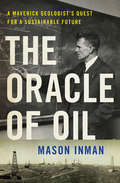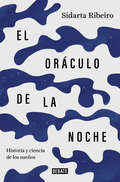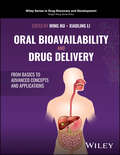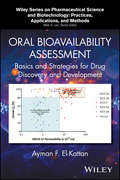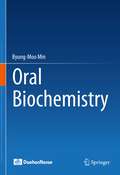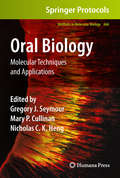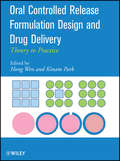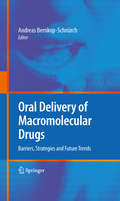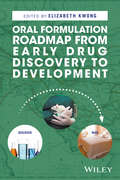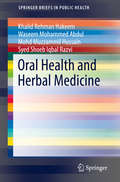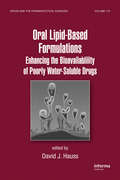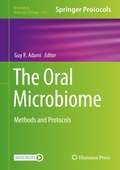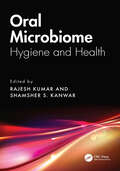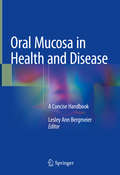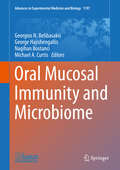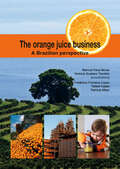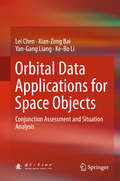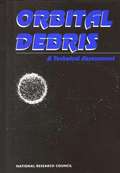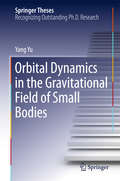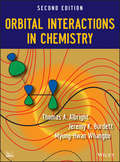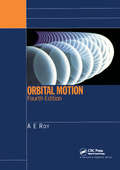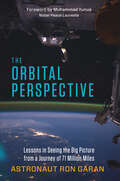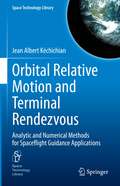- Table View
- List View
The Oracle of Oil: A Maverick Geologist's Quest for a Sustainable Future
by Mason InmanThe first comprehensive biography of Marion King Hubbert, the "father of peak oil." In 1956, geologist and Shell Oil researcher Marion King Hubbert delivered a speech that has shaped world energy debates ever since. Addressing the American Petroleum Institute, Hubbert dropped a bombshell on his audience: U.S. oil production would peak by 1970 and decline steadily thereafter. World production would follow the same fate, reaching its peak soon after the turn of the millennium. In battles stretching over decades, Hubbert defended his forecasts against opponents from both the oil industry and government. Hubbert was proved largely correct during the energy crises of the 1970s and hailed as a "prophet" and an "oracle." Even amid our twenty-first-century fracking boom, Hubbert's underlying logic holds true--while remaining a source of debate and controversy. A rich biography of the man behind peak oil, The Oracle of Oil follows Hubbert from his early days as a University of Chicago undergraduate to his first, ill-fated forays into politics in the midcentury Technocracy movement, and charts his rise as a top geologist in the oil industry and energy expert within the U.S. government. In a deeply researched narrative that mines Hubbert's papers and correspondence for the first time, award-winning journalist Mason Inman rescues the story of a man who shocked the scientific community with his eccentric brilliance. The Oracle of Oil also skillfully situates Hubbert in his era: a time of great intellectual ferment and discovery, tinged by dark undercurrents of intellectual witch hunts. Hubbert emerges as an unapologetic iconoclast who championed sustainability through his lifelong quest to wean the United States--and the wider world--off fossil fuels, as well as by questioning the pursuit of never-ending growth. In its portrait of a man whose prescient ideas still resonate today, The Oracle of Oil looks to the past to find a guiding philosophy for our future.
El oráculo de la noche: Historia y ciencia de los sueños
by Sidarta RibeiroUna fascinante historia de la mente humana a través del hilo conductor del sueño. A fin de cuentas, ¿qué es un sueño? ¿Por qué soñamos? Y, más interesante aún, ¿para qué soñamos? ¿Cómo podemos extraer sentido de sus variados símbolos, tan llenos de detalles y significados? En este libro amplio y multidisciplinario, el reconocido neurocientífico especialista en sueños Sidarta Ribeiro se basa en conocimientos históricos, antropológicos, psicoanalíticos y literarios, además de en las referencias más actualizadas de la biología molecular, la neurofisiología y la medicina, para responder a estas y muchas otras preguntas sobre uno de los grandes enigmas de la humanidad. Reseña:«El autor aborda una teoría general del sueño que engloba pasado y futuro, y explica la función onírica como una herramienta crucial para sobrevivir al presente.»Correio Braziliense
Oral Bioavailability and Drug Delivery: From Basics to Advanced Concepts and Applications (Wiley Series in Drug Discovery and Development)
by Ming Hu Xiaoling LiORAL BIOAVAILABILITY AND DRUG DELIVERY Improve the performance and viability of newly-developed and approved drugs with this crucial guide Bioavailability is the parameter which measures the rate and extent to which a drug reaches a user’s circulatory system depending on the method of administration. For example, intravenous administration produces a bioavailability of 100%, since the drugs are injected directly into the circulatory system; in the case of oral administration, however, bioavailability can vary widely based on factors which, if not properly understood, can result in a failure in drug development, adverse effects, and other complications. The mechanics of oral bioavailability are therefore critical aspects of drug development. Oral Bioavailability and Drug Delivery provides a comprehensive coverage of this subject as well as its drug development applications. Beginning with basic terminology and fundamental concepts, it provides a thorough understanding of the challenges and barriers to oral bioavailability as well as the possibilities for improving this parameter. The resulting book is an indispensable tool for drug development research. Oral Bioavailability and Drug Delivery readers will also find: Discussion questions in many chapters to facilitate comprehension Detailed discussion of topics including dissolution, absorption, metabolism, and more Real-world examples of methods in actions throughout Oral Bioavailability and Drug Delivery is ideal for pharmaceutical and biotechnology scientists working in drug discovery and development; researchers in chemistry, biology, pharmacology, immunology, neuroscience, and other related fields; and graduate courses in drug development and delivery.
Oral Bioavailability Assessment: Basics and Strategies for Drug Discovery and Development
by Ayman F. El-Kattan Mike S. LeeSpecifically geared to personnel in the pharmaceutical and biotechnology industries, this book describes the basics and challenges of oral bioavailability – one of the most significant hurdles in drug discovery and development.• Describes approaches to assess pharmacokinetics and how drug efflux and uptake transporters impact oral bioavailability• Helps readers reduce the failure rate of drug candidates when transitioning from the bench to the clinic during development• Explains how preclinical animal models – used in preclinical testing – and in vitro tools translate to humans, which is an underappreciated and complicated area of drug development• Includes chapters about pharmacokinetic modelling, the Biopharmaceutics Drug Disposition Classification System (BDDCS), and the Extended Clearance Classification System (ECCS)• Has tutorials for applying strategies to medicinal chemistry practices of drug discovery/development
Oral Biochemistry
by Byung-Moo MinThis book provides the reader with a comprehensive understanding of oral biochemistry by explaining the role of basic biochemistry and dentistry concepts and identifying their metabolic processes of soft tissues that comprise oral and maxillofacial anatomy. The book also discusses how metabolic abnormalities are related to the development of oral diseases. Readers will gain a comprehensive perspective on a variety of oral conditions and related metabolic abnormalities. Individual chapters are focused on crucial topics such as enamel, dentine, saliva, fluoride, and many more. The importance of evidence-based explanation and case study details are also highlighted. Oral biochemistry is the first book to be devoted entirely to this area, and it will be of interest to researchers, students, and practitioners.
Oral Biology
by Mary P. Cullinan Gregory J. Seymour Nicholas C.K. HengWith so many major advances over the past two decades coming through the application of molecular biology and nanotechnology, it is essential that dental research, education, and practice keep pace with the rapid progress of science. In Oral Biology: Molecular Techniques and Applications, expert researchers in the field have provided a selection of in depth methods and techniques optimized for particular applications, which can be readily adapted to particular organisms or areas of interest. Divided into three convenient sections, the book covers the study of saliva, as it is a rich source of biomolecules for study at the molecular level, which may lead to the identification of susceptibility to particular diseases, the study of the microbial inhabitants that share the oral cavity with us, as well as a range of protocols that facilitate assessment of the molecular behavior of oral cells and tissues in health and during disease progression. Written in the highly successful Methods in Molecular BiologyTM series format, chapters include introductions to their respective topics, lists of the necessary materials and reagents, step-by-step, reproducible laboratory protocols, and tips on troubleshooting and avoiding known pitfalls. Authoritative and cutting-edge, Oral Biology: Molecular Techniques and Applications is an ideal resource not only to the new researcher but also to the seasoned laboratory veteran including cell biologists, microbiologists, and any researchers intent on delving into the vital world of oral biology.
Oral Controlled Release Formulation Design and Drug Delivery
by Kinam Park Hong WenThis book describes the theories, applications, and challenges for different oral controlled release formulations. This book differs from most in its focus on oral controlled release formulation design and process development. It also covers the related areas like preformulation, biopharmaceutics, in vitro-in vivo correlations (IVIVC), quality by design (QbD), and regulatory issues.
Oral Delivery of Macromolecular Drugs
by Andreas Bernkop-SchnürchRecent and rapid progress in the field of biotechnology has resulted in an increasing number of novel macromolecular drugs with great promise for further advanced research and clinical application. However, the delivery of these macromolecular drugs by routes other than the parenteral route is difficult. The pipeline of macromolecular drugs derived from biotechnology presents a challenging opportunity to develop practical dosage forms that could be dosed via the oral route. Given this, the successful oral delivery of macromolecular drugs presents an enormous opportunity. Oral Delivery of Macromolecular Drugs will provide an overview of the innovative oral delivery technologies that have demonstrated success in human testing and will go on to cite the challenges, strategies, and future trends that are to be expected.
Oral Formulation Roadmap from Early Drug Discovery to Development
by Elizabeth KwongDetailing formulation approaches by stage of discovery to early development, this book gives a “playbook” of practical and efficient strategies to formulate drug candidates with the least chance of failing in clinical development. • Comes from contributing authors with experience developing formulations on the frontlines of the pharmaceutical industry• Focuses on pre (or non-) clinical and early stage development, the phases where most compounds are used in drug research• Features case studies to illustrate practical challenges and solutions in formulation selection• Covers regulatory filing, drug metabolism and physical and chemical properties, toxicology formulation, biopharmaceutics classification system (BCS), screening approaches, early stage clinical formulation development, and outsourcing
Oral Health and Herbal Medicine (SpringerBriefs in Public Health)
by Syed Shoeb Razvi Mohd Muzzammil Hussain Waseem Mohammed Abdul Khalid Rehman HakeemOral health loss is one of the major problems existing all over the world and is one of the top causes of death when unmanaged. The oral cavity is home to numerous pathogenic microorganisms, some of which are responsible for the progression and development of various systemic diseases such as cancer, diabetes and myocardial infarction. Worldwide, 60–90% of school children and nearly 100% of adults have dental cavities, often leading to pain and discomfort. There are implications for the global economy as well, due to the continuous burden of investing resources to maintain oral hygiene. Not surprisingly, developing countries are disproportionally affected. There is thus an urgent need to develop economical solutions for the treatment of oral diseases. The trend of exploring plants or plant-derived compounds for the prevention and cure of death-causing diseases is on the rise. The use of traditional medicine for oral diseases is an ancient practice in which medicinal herbs play a major role. Medicinal plants have minimal side effects and no denigrating properties. Accordingly the use of medicinal plants to curtail oral pathogens has been reported by a number of studies.The present book updates the issues related to oral health, oral diseases and the role of medicinal plants in overcoming orally-derived health problems. We also highlight the knowledge gaps in oral health related problems with medicinal plants as one of the solutions. Our ultimate goal is to encourage future research and application of medicinal plants for economical and efficient treatment of oral diseases.
Oral Lipid-Based Formulations: Enhancing the Bioavailability of Poorly Water-Soluble Drugs (Drugs and the Pharmaceutical Sciences)
by David J. HaussOral lipid-based formulations are attracting considerable attention due to their capacity to facilitate gastrointestinal absorption and reduce or eliminate the effect of food on the absorption of poorly water-soluble, lipophilic drugs. Despite the obvious and demonstrated utility of these formulations for addressing a persistent and growing problem
The Oral Microbiome: Methods and Protocols (Methods in Molecular Biology #2327)
by Guy R. AdamiThis volume discusses the oral microbiome, and oral and systemic health. The chapters in this book cover topics such as analytical techniques for identifying and measuring oral bacteria; strategies for controlling common sources of variability in oral microbiome methods for viral bacterial and fungal analysis; ways to study oral DNA and RNA samples to identify molecular pathways to disease; approaches to functional assays for oral bacteriophage, antibiotic purging of systemic bacteria; and metaproteomic analysis of various oral samples. Written in the highly successful Methods in Molecular Biology series format, chapters include introductions to their respective topics, lists of the necessary materials and reagents, step-by-step, readily reproducible laboratory protocols, and tips on troubleshooting and avoiding known pitfalls. Cutting-edge and practical, The Oral Microbiome: Methods and Protocols is a valuable resource for any scientist or researcher looking to further study this exciting and developing field.
Oral Microbiome: Hygiene and Health
by Rajesh Kumar Shamsher S. KanwarThis book comprehensively reviews the intricate and multifaceted role of the oral microbiome in overall health and well-being. The introductory chapters present the diverse bacterial consortium inhabiting the oral cavity and the influence of dietary habits on the nature of the oral microbiome. The book investigates the link between the gut microbiome and susceptibility to disease, expanding the understanding of the interconnectedness of the human microbiota. Further, the book discusses the involvement of the oral microbiome in acute and chronic infections and addresses the concerning issue of drug resistance within this complex environment. It unveils the connection between the oral microbiome and mouth cancer and malignancies, presenting critical insights into disease prevention and management. The book also expands the scope, examining the role of the oral microbiome in systemic infections and revealing connections between oral bacteria and cardiac diseases. Towards the end, the book explores the pivotal role of oral microbiota in children’s well-being and reviews the various diagnostic techniques associated with the oral microbiome. This book is intended for researchers in the fields of microbiology and immunology, dentists, oral health specialists, physicians, and health care practitioners.
Oral Mucosa in Health and Disease
by Lesley Ann BergmeierThis book is designed to re-establish the position of the oral cavity and its mucosa at the forefront of defence and maintenance of homeostatic mechanisms that protect against disease not just locally but also systemically. The oral mucosa is a unique collection of tissues that constitutes a highly active environment with its own unique microflora and homeostatic interaction with the innate and adaptive immune responses. As an immune tissue the oral mucosa was somewhat neglected in the past owing to the tendency to assume similarity to the gut mucosa. More recently it has become apparent that the oral mucosa is a complex environment and, like the esophageal mucosa, has more in common with vaginal tissue than with the gut. Furthermore, the ability of the oral mucosa to act as an immune inductive site has made it an attractive area of research in terms of desensitization for allergic reactions and possibly autoimmune responses. In this book, recognized experts in the field provide up-to-date coverage of all aspects of the structure and function of the oral mucosa, reflecting important recent advances in knowledge, including at the molecular level.
Oral Mucosal Immunity and Microbiome (Advances in Experimental Medicine and Biology #1197)
by Georgios N. Belibasakis George Hajishengallis Nagihan Bostanci Michael A. CurtisThe first International Conference on Oral Mucosal Immunity and Microbiome (OMIM) aimed to highlight cutting-edge basic and translational research from an oral immunological and microbiological perspective. Oral diseases with a microbial etiology are the most prevalent chronic diseases of humans. Whilst not life-threatening, they can significantly compromise quality of life, are associated with increased risk for certain systemic diseases, and pose heavy financial burdens to national health systems. Hence, periodontal and peri-implant diseases, dental caries, root canal infections and mucosal infections are significant global public health problems.In this book global experts summarize and discuss the latest progress made in oral mucosal immunity and the oral microbiome. Target audience is basic and/or translational researchers with expertise in host immunity and microbiome research, and interest in oral health and disease. This volume provides a much needed quantum leap in the field, by joining forces to address gaps at the oral mucosal immunity-microbiome cross-talk.
The orange juice business: A Brazilian perspective
by Marcos Fava Neves Vinicius Gustavo Trombin Frederico Fonseca Lopes Patrícia Milan Rafael KalakiThe orange juice chain is unique, probably a sui generis commodity. Although several countries produce oranges and juices, two regions in the world are the responsible for around 80% of the production. These are the states of Sao Paulo in Brazil and Florida in the USA. Although the emerging countries are growing in production, the juice consumer is also concentrated in the USA and Europe where more than 90% of consumption takes place. The characteristics of this chain are so unique, that it makes a nice laboratory for academics and business people to exercise strategies, since risk is spread. Orange is a very sensitive plant, and fluctuations in production are notorious. The logistics of this chain are fascinating. The product travels great distances to reach the consumer in a generally safe and efficient way. The industry assets such as vessels and tanks are specific. By reading this book, business people, academics and chain practitioners have an opportunity to understand this chain. and can analyse all of its numbers and economics and exercise strategy building. This is needed since the orange juice market is a stable market in the world, growing only 1% per year, and the production costs of this chain are rising fast, due to structural changes faced by world food and agribusiness companies i.e. labour costs, energy costs, land costs, environmental costs and others. The book will be of interest to all those concerned with agri food chains.
Orbit and Rotation: Science Logbook (PhD Science™ #Level 5, Module 4)
by Great MindsNIMAC-sourced textbook
Orbital Data Applications for Space Objects
by Lei Chen Xian-Zong Bai Yan-Gang Liang Ke-Bo LiThis book introduces readers to the application of orbital data on space objects in the contexts of conjunction assessment and space situation analysis, including theories and methodologies. It addresses the main topics involved in space object conjunction assessment, such as: orbital error analysis of space objects; close approach analysis; the calculation, analysis and application of collision probability; and the comprehensive assessment of collision risk. In addition, selected topics on space situation analysis are also presented, including orbital anomaly and space event analysis, and so on. The book offers a valuable guide for researchers and engineers in the fields of astrodynamics, space telemetry, tracking and command (TT&C), space surveillance, space situational awareness, and space debris, as well as for graduates majoring in flight vehicle design and related fields.
Orbital Debris: A Technical Assessment
by Committee on Space DebrisSince the beginning of space flight, the collision hazard in Earth orbit has increased as the number of artificial objects orbiting the Earth has grown. Spacecraft performing communications, navigation, scientific, and other missions now share Earth orbit with spent rocket bodies, nonfunctional spacecraft, fragments from spacecraft breakups, and other debris created as a byproduct of space operations. Orbital Debris examines the methods we can use to characterize orbital debris, estimates the magnitude of the debris population, and assesses the hazard that this population poses to spacecraft. Potential methods to protect spacecraft are explored. The report also takes a close look at the projected future growth in the debris population and evaluates approaches to reducing that growth. Orbital Debris offers clear recommendations for targeted research on the debris population, for methods to improve the protection of spacecraft, on methods to reduce the creation of debris in the future, and much more.
Orbital Dynamics in the Gravitational Field of Small Bodies
by Yang YuThis prizewinning PhD thesis presents a general discussion of the orbital motion close to solar system small bodies (SSSBs), which induce non-central asymmetric gravitational fields in their neighborhoods. It introduces the methods of qualitative theory in nonlinear dynamics to the study of local/global behaviors around SSSBs. Detailed mechanical models are employed throughout this dissertation, and specific numeric techniques are developed to compensate for the difficulties of directly analyzing. Applying this method, several target systems, like asteroid 216 Kleopatra, are explored in great detail, and the results prove to be both revealing and pervasive for a large group of SSSBs.
Orbital Interactions in Chemistry
by Jeremy K. Burdett Myung-Hwan Whangbo Thomas A. AlbrightExplains the underlying structure that unites all disciplines in chemistryNow in its second edition, this book explores organic, organometallic, inorganic, solid state, and materials chemistry, demonstrating how common molecular orbital situations arise throughout the whole chemical spectrum. The authors explore the relationships that enable readers to grasp the theory that underlies and connects traditional fields of study within chemistry, thereby providing a conceptual framework with which to think about chemical structure and reactivity problems.Orbital Interactions in Chemistry begins by developing models and reviewing molecular orbital theory. Next, the book explores orbitals in the organic-main group as well as in solids. Lastly, the book examines orbital interaction patterns that occur in inorganic-organometallic fields as well as cluster chemistry, surface chemistry, and magnetism in solids.This Second Edition has been thoroughly revised and updated with new discoveries and computational tools since the publication of the first edition more than twenty-five years ago. Among the new content, readers will find:Two new chapters dedicated to surface science and magnetic propertiesAdditional examples of quantum calculations, focusing on inorganic and organometallic chemistryExpanded treatment of group theoryNew results from photoelectron spectroscopyEach section ends with a set of problems, enabling readers to test their grasp of new concepts as they progress through the text. Solutions are available on the book's ftp site.Orbital Interactions in Chemistry is written for both researchers and students in organic, inorganic, solid state, materials, and computational chemistry. All readers will discover the underlying structure that unites all disciplines in chemistry.
Orbital Mechanics and Astrodynamics: Techniques and Tools for Space Missions
by Gerald R. HintzNow in an updated second edition, this classroom-tested textbook covers fundamental and advanced topics in orbital mechanics and astrodynamics designed to introduce readers to the basic dynamics of space flight. The book explains concepts and engineering tools a student or practicing engineer can apply to mission design and navigation of space missions. Through highlighting basic, analytic, and computer-based methods for designing interplanetary and orbital trajectories, the text provides excellent insight into astronautical techniques and tools. The second edition includes new material on the observational basics of orbit determination, information about precision calculations for data used inflight, such as Mars 2020 with the Ingenuity Helicopter, and improvements in mission design procedures, including the automated design of gravity-assist trajectories. Orbital Mechanics and Astrodynamics: Techniques and Tools for Space Missions is ideal for students in astronautical or aerospace engineering and related fields, as well as engineers and researchers in space industrial and governmental research and development facilities, as well as researchers in astronautics.
Orbital Motion
by A.E. RoyLong established as one of the premier references in the fields of astronomy, planetary science, and physics, the fourth edition of Orbital Motion continues to offer comprehensive coverage of the analytical methods of classical celestial mechanics while introducing the recent numerical experiments on the orbital evolution of gravitating masses and the astrodynamics of artificial satellites and interplanetary probes. Following detailed reviews of earlier editions by distinguished lecturers in the USA and Europe, the author has carefully revised and updated this edition. Each chapter provides a thorough introduction to prepare you for more complex concepts, reflecting a consistent perspective and cohesive organization that is used throughout the book. A noted expert in the field, the author not only discusses fundamental concepts, but also offers analyses of more complex topics, such as modern galactic studies and dynamical parallaxes. New to the Fourth Edition: * Numerous updates and reorganization of all chapters to encompass new methods * New results from recent work in areas such as satellite dynamics * New chapter on the Caledonian symmetrical n-body problem Extending its coverage to meet a growing need for this subject in satellite and aerospace engineering, Orbital Motion, Fourth Edition remains a top reference for postgraduate and advanced undergraduate students, professionals such as engineers, and serious amateur astronomers.
The Orbital Perspective: Lessons in Seeing the Big Picture from a Journey of 71 Million Miles
by Ron GaranFor astronaut Ron Garan, living on the International Space Station was a powerful, transformative experience—one that he believes holds the key to solving our problems here on Earth. On space walks and through windows, Garan was struck by the stunning beauty of the Earth from space but sobered by knowing how much needed to be done to help this troubled planet. And yet on the International Space Station, Garan, a former fighter pilot, was working work side by side with Russians, who only a few years before were “the enemy.” If fifteen nationalities could collaborate on one of the most ambitious, technologically complicated undertakings in history, surely we can apply that kind of cooperation and innovation toward creating a better world. That spirit is what Garan calls the “orbital perspective.”Garan vividly conveys what it was like learning to work with a diverse group of people in an environment only a handful of human beings have ever known. But more importantly, he describes how he and others are working to apply the orbital perspective here at home, embracing new partnerships and processes to promote peace and combat hunger, thirst, poverty, and environmental destruction. This book is a call to action for each of us to care for the most important space station of all: planet Earth. You don't need to be an astronaut to have the orbital perspective. Garan's message of elevated empathy is an inspiration to all who seek a better world.
Orbital Relative Motion and Terminal Rendezvous: Analytic and Numerical Methods for Spaceflight Guidance Applications (Space Technology Library #39)
by Jean Albert KéchichianThis book provides a comprehensive analysis of time-fixed terminal rendezvous around the Earth using chemical propulsion.The book has two main objectives. The first is to derive the mathematics of relative motion in near-circular orbit when subjected to perturbations emanating from the oblateness of the Earth, third-body gravity, and atmospheric drag. The mathematics are suitable for quick trajectory prediction and the creation of computer codes and efficient software to solve impulsive maneuvers and fly rendezvous missions.The second objective of this book is to show how the relative motion theory is applied to the exact precision-integrated, long-duration, time-fixed terminal rendezvous problem around the oblate Earth for the general elliptic orbit case.The contents are both theoretical and applied, with long-lasting value for aerospace engineers, trajectory designers, professors of orbital mechanics, and students at the graduate level and above.
